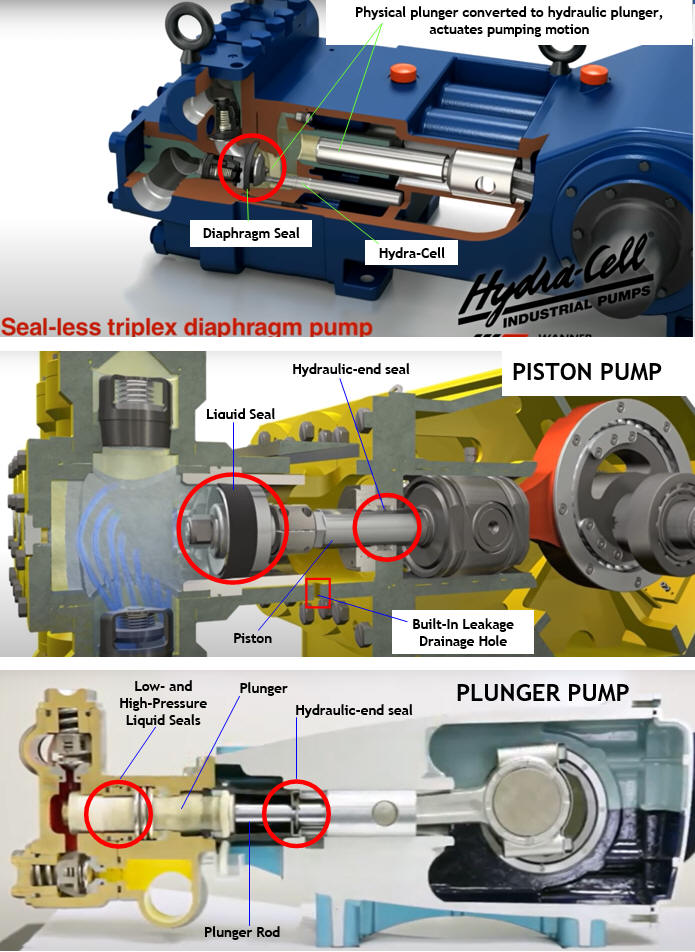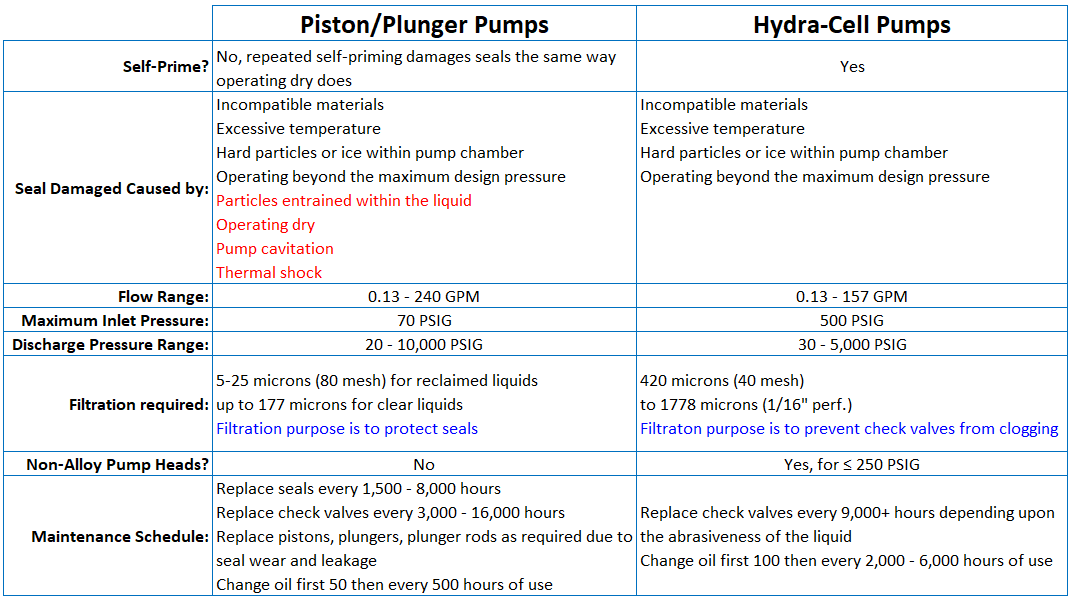Wanner™ Hydra-Cell® Pro Pumps Compared to Piston and Plunger Pumps
Comparison of pump designs with Application Examples
 Piston
and plunger pumps are both positive displacement pumps that use
reciprocating motion to move fluid through a system. Wanner™
Hydra-Cell® Pro pumps are a
proprietary and patented design of positive displacement pumps which are
similar to piston and plunger pumps with regards to their pumping action,
except Hydra Cell Pro
pumps do not have dynamic seals. This is a significant
distinction and advantage for the Hydra Cell Pro
design because not only do they
require less stringent filtration than piston and plunger pumps do, it also
broadens their application base to include pumping liquids at extreme
temperatures, pumping non-lubricating liquids, remaining undamaged when cavitated and pumping shear sensitive liquids. The Achilles’ heel of the
piston and plunger pump designs are the seals and packing that they use to
prevent leakage of the pumped liquid; worn seals and packing are the pathway
for fugitive emissions, increased downtime and maintenance costs. Piston and
plunger pump designs are very similar with regards to how the process
liquid is sealed and prevented from following the piston/plunger.
Piston
and plunger pumps are both positive displacement pumps that use
reciprocating motion to move fluid through a system. Wanner™
Hydra-Cell® Pro pumps are a
proprietary and patented design of positive displacement pumps which are
similar to piston and plunger pumps with regards to their pumping action,
except Hydra Cell Pro
pumps do not have dynamic seals. This is a significant
distinction and advantage for the Hydra Cell Pro
design because not only do they
require less stringent filtration than piston and plunger pumps do, it also
broadens their application base to include pumping liquids at extreme
temperatures, pumping non-lubricating liquids, remaining undamaged when cavitated and pumping shear sensitive liquids. The Achilles’ heel of the
piston and plunger pump designs are the seals and packing that they use to
prevent leakage of the pumped liquid; worn seals and packing are the pathway
for fugitive emissions, increased downtime and maintenance costs. Piston and
plunger pump designs are very similar with regards to how the process
liquid is sealed and prevented from following the piston/plunger.
Comparison of Piston/Plunger and Hydra Cell Pro Designs
The drive end of both designs is similar in that a swash plate or cam shaft is used to actuate a method of progressively increasing and decreasing multiple pump chambers in series. In piston/plunger pumps a cylinder moves back and forth into a pump chamber, reducing the volume within it on the forward stroke and increasing the pump chamber volume with the withdraw stroke. The circumference of the piston/plunger needs to be sealed to prevent the high pressure liquid from leaking along the piston/plunger. There are usually multiple liquid end and hydraulic end seals made of non-alloy materials such as PTFE, PE, PEEK or an elastomer such as Nitrile rubber. These seals are lubricated by the liquid pumped and enable the piston/plunger to slide in and out of the pump chamber without loss of the pumped liquid.
The interface of the piston/plunger and seal is subject to accelerated wear when pumping:
-
reclaimed or abrasive liquids
-
hot liquids
-
operated dry (they require priming prior to operation)
-
cavitation caused by aerated liquid or an inlet line restriction.
The most common cause of leakage is due to particles within the liquid pumped. These particles get in-between the piston/plunger and seal, wearing both. This is one reason why ceramic plungers are often used in plunger pumps; the ceramic material is resistant to abrasive wear.
Piston/plunger pumps require the pumped liquid to be filtered to at least 80 mesh (±177 microns) but when the liquid is reclaimed it is recommend filtering to AT LEAST 50 microns and limiting the particle load to ≤50 PPM (±5%) to minimize abrasive wear. Operating dry and elevated liquid temperatures are also problematic for piston and plunger style pumps because seals are dependent upon the liquid being pumped for cooling and lubrication.
The innovation Hydra Cell Pro pumps employ are replacing the solid alloy pistons and plungers with synthetic motor oil, and they use this “hydraulic piston” to actuate a diaphragm for each pump chamber. The diaphragm has a short stroke and is “sealed” by its compression between the pump head and pump body. Thus, it is a static seal and not a dynamic seal, so particles, dry operation, cavitation and extreme liquid temperatures do not damage the pump or contribute to wear that results in leakage. The leakage pathway that piston/plunger pumps have is eliminated with the Hydra Cell Pro design.
The Hydra Cell Pro diaphragm is designed with a built-in convolute, so it doesn’t actually “flex” as much as “rolls” on the built-in geometry. With exception to PTFE encapsulated diaphragms, Hydra Cell Pro pump diaphragms are not considered to be a wear item. Recently a customer contacted us for a fluid end kit for their D10 pump, it is 11 years old and used for over 20,000 hours before their check valves wore-out. Their application is pumping reclaimed machine tool coolant at pressures up to 1,000 PSIG. The diaphragms are fine, but they, like most customers, will elect to change the diaphragms also since the pump is already being serviced. Diaphragms are much less costly to replace than plungers and plunger rods.
Diaphragms are not considered a wear component because they are hydraulically balanced - there is never more than a 2 PSI pressure differential on either side of the diaphragm. A nested check valve (the “Hydra-Cell”) behind each diaphragm provides automatic and continuous pressure regulation. You can mimic hydraulic balancing with a sheet of tissue paper between your hands. No matter how hard you press your hands together the tissue paper remains undamaged because the pressure on either side was equal – this is the same principle behind the Hydra Cell Pro pumps hydraulically balanced diaphragm design.
Plunger pumps also have dynamic seals around the plunger rod which are subject to wear from seal damage unless the liquid and hydraulic sections of the pump are separated.
Nonetheless the diaphragm is a type of seal in a Hydra Cell Pro pump, and it can be damaged if the:
-
liquid pumped is incompatible with the diaphragm material
-
pump is operated beyond its design MAWP
-
liquid contains large hard particles which become entrapped within the pump chamber, which can include ice formation
-
liquid temperature exceeds the limitation of the diaphragm material

Where the leakage goes
When the
seals of a piston/plunger pump leak, the hydraulic oil or process liquid
enters the general environment, but with most designs there is no chance of
cross contamination between hydraulic and process fluids.
When a diaphragm becomes damaged, cross contamination is likely. If the inlet pressure is positive, the leakage pathway is through the hydraulic end of the pump and when the inlet is simply flooded or a suction lift condition, some of the synthetic motor oil will leak into the process liquid. Thus, for certain types of applications where cross contamination is problematic, Wanner offers oil rated for food contact, oil that resists breakdown from ammonia permeation and oil that is water soluble.
The volume of oil than can leak through a diaphragm is miniscule; as soon as a diaphragm is damaged its displacement is reduced, visibility and audibly affecting pump performance with chattering noise and erratic pressure swings.
Wanner does offer oil level monitors designed to automatically detect diaphragm damage and signal a PLC for sensitive liquid applications.
Flow Ranges
Piston pumps generally have a higher flow rate than plunger pumps and are used for lower pressure applications. This is because the piston rings used to seal the piston against the cylinder walls can become damaged at higher pressures. Plunger pumps can generate higher pressures because the seal used to prevent fluid leakage is more robust.
Hydra Cell Pro pumps can output pressures up to 5,000 PSI, although most applications require <1,000 PSI. That is because the sealless design enables Hydra Cell Pro pumps to be used in a broader application range, involving difficult to pump liquids that would quickly destroy piston and plunger style pumps and many of these applications do not require high pressures, just accurate and reliable dosing/metering.
Maintenance
Piston/Plunger pumps and Hydra Cell Pro pumps are not difficult to service. The main difference between the designs is the frequency of service and how that may impact productivity as well as operational costs.
Applications
There is much overlap in applications for piston, plunger and Hydra Cell Pro pumps. All are used for high pressure water, oil/gas field well injection, and high-pressure atomization applications. Piston pumps are typically capable of higher pressures than comparable sized Hydra Cell Pro pumps. The Hydra Cell Pro design can handle a wide range of liquids, including corrosive and abrasive liquids, without suffering damage to the pump or a reduction in performance. Any application that results in frequent seal/packing wear and damaged pistons/plungers is a candidate for a Hydra Cell Pro pump.





